Electrolux EWF1041R9WB review
Front loading washing machine. 10kg capacity. Priced at $1399.
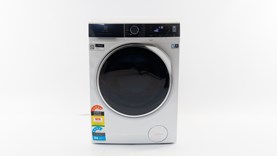
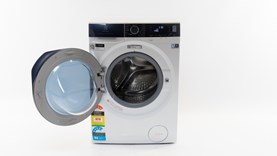
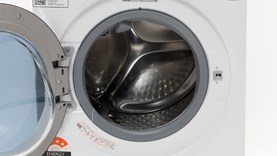
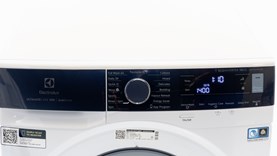
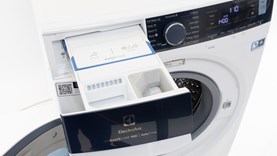
Good points
Bad points

Unlock our expert review and more
- Reviews and ratings you can trust
- Easy side-by-side comparison
- Recommended products at a glance
-
Type
View more details.
In Australia the main types of washing machines are front loader and top loader. Twin tubs exist but have a tiny market share.
- Front loading
-
Recommended
View more details.
We recommend front loaders with a CHOICE Expert Rating of at least 70% and 75% for dirt removal and no other score below 60%. We recommend top loaders with a CHOICE Expert Rating of at least 70% and 75% for dirt removal.
-
CHOICE Expert Rating
View more details.
The CHOICE Expert Rating is made up of dirt removal (40%), rinse performance (20%), gentleness (15%), water efficiency (15%) and spin efficiency (10%). Models with cycle times longer than 90 minutes receive a small penalty.
-
Dirt removal score
View more details.
We measure dirt removal with a spectrophotometer, a machine that's more accurate than the human eye and can detect differences of about 6%.
-
Rinse performance score
View more details.
We measure how well the machines keep dirt suspended in the water rather than depositing it back on the clothes, and how well they rinse out detergent by adding a marker chemical at the start of the wash, and measuring how much of it remains in the rinse liquor at the end of the cycle.
-
Gentleness score
View more details.
We test how gentle a washing machine is on clothes by attaching swatches of loose weave fabric to our test load, then measuring how much has frayed off by the end of the cycle. The less fraying, the higher the gentleness score.
-
Water efficiency score
View more details.
This shows you how efficiently a washer uses water. To compare efficiency between different-sized machines, we calculate the amount of water used per kilogram of laundry. The lower the water consumption per kilogram, the higher the efficiency score.
-
Spin efficiency score
View more details.
The test load is weighed before and after each wash. Higher scores mean more water is removed, which means the washing takes less time to dry. We use the default spin speed (some machines let you vary the speed).
-
Water used (L)
View more details.
The amount of water used during the entire program cycle in our test. Other programs will almost certainly use different volumes of water.
-
Energy used (kWh)
View more details.
The amount of energy used per laundry cycle. A washer generally makes up around 0.53% of annual household energy usage. The smaller the number, the lower your running costs.
-
Cycle time (minutes)
View more details.
The amount of time the program cycle we selected took. This can range from under an hour to over three hours.
-
Noise (dBA)
View more details.
The maximum noise level is recorded during the spin cycle of the tested program, and is measured one metre away from the machine and one metre above the ground. Typically, the noise level of these machines is similar to that of a normal conversation (about 65dB). It's not an absolute measurement, the acoustics of your home will determine exactly how a machine sounds in use, but it's a good comparative measure.
-
Shop Ethical rating
View more details.
Shop Ethical rates the environmental and social impact of the company (not the product) using independent sources. This rating is not included in our total score. The rating ranks from A (highest) to F (lowest); N/A means there is no rating for that company.
- C
-
Energy star rating
View more details.
As claimed by the manufacturer. The higher the number, the more energy-efficient the washing machine.
- 5
-
Claimed energy use (kWh/year)
View more details.
Energy use, based on 365 uses per year, as claimed by the manufacturer.
- 224
-
Energy star program used
View more details.
The wash program used to determine the energy star rating. Manufacturers tend to choose a program that uses the least power and water to attain the most stars possible.
- Energy saver, 40°C, 1400rpm, Off Autodose detergent, Off Autodose softener
-
Water star rating
View more details.
The higher the number, the more water-efficient the washing machine.
- 4.5
-
Claimed water use (L)
View more details.
Water use per wash cycle, as claimed by the manufacturer.
- 86
-
Reliability score
View more details.
A high score means the washing machine brand (not the model) is less likely to have faults over time, according to CHOICE members.
-
Satisfaction score
View more details.
A high score means CHOICE members are satisfied with the brand of washing machine (not the model).
-
Service score
View more details.
A high score means CHOICE members were happy with the support they received from this brand when they had a problem with their washing machine.
-
Warranty (years)
View more details.
Stated warranty of the washing machine. You're still covered by the Australian Consumer Law regardless of the manufacturer warranty.
- 2
-
Country of origin
View more details.
Where the washing machine was manufactured, though parts may have been sourced from other places.
- Thailand
-
Availability
View more details.
We include some discontinued models in our test results as they may still be available online or second-hand. 'Tested' models should still be available in stores.
- Tested model
-
Similar models
View more details.
Most washer manufacturers make a family of models that are based on a common platform but offer different features and programs, often at different price points, and sometimes allowing a retailer to offer an exclusive product, though the core performance will be identical.
- None
-
Differences
View more details.
Any differences between models that we've been able to ascertain.
- Not applicable
-
Price
View more details.
The manufacturer's recommended retail price. Prices are generally flexible, so shop around both online and in bricks-and-mortar shops for options.
- $1399
-
10-year running cost
View more details.
Approximate cost over 10 years for one daily load on a 'normal' cycle, based on 40c/kWh for electricity and $2 per 1000L for water. Excludes detergent (which can be a third of the cost).
-
Capacity (kg)
View more details.
This is the claimed capacity. We find people rarely fill their washer to full, so base your decision on how heavy your common load is. Weigh it on your scales.
- 10
-
Program tested
View more details.
We test on a normal, cold wash or the closest approximation to it, because that's how most Australians wash. You'll sometimes see differences between what the energy and water labels say on the machine and our results, because these are calculated on a warm wash, and potentially a different program.
- Cottons, Cold, 1400rpm, 3:03 to go, Off Autodose detergent, Off Autodose softener
-
Coldest wash for normal program
View more details.
Since most Australians wash in cold water, we've applied a small penalty in our overall score to models that can't do a proper cold wash (our water is at 20 degrees C) on their 'normal' cycle.
- Cold
-
Tap connection
View more details.
Some machines require both hot and cold water to operate, whereas others (typically front loaders) have an internal heater and only require a cold water connection. A front loader with the option to connect to a hot tap can reduce your running costs if you have solar hot water.
- Cold
-
Minimum water pressure (kPa)
View more details.
Washers require a minimum water pressure in order to function correctly. You can check with your local water supplier for the water pressure to your house.
- 50
-
Maximum hot water inlet temp
View more details.
Where washers accept a hot water source, there can be a cap on how high the temperature can be before it affects the hose or internal mechanisms. Usually this can be regulated by your heater, or a tempering valve can be fixed to the inlet if your water temperature is higher than accepted.
- Not stated
- Maximum speed (rpm)
- 1400
-
Drum type
View more details.
'Drum' refers to a front loader with a drum that rotates on a horizontal axis, picking your clothes up and dropping them in the wash water. 'Impeller' refers to a top loader with a slimline 'propeller' in the bottom of the drum. 'Agitator' refers to a big 'spike' in the middle of the toploader drum which stirs the water around.
- Drum
-
Dimensions (cm, H x W x D)
View more details.
The dimensions listed are the smallest figures claimed by the manufacturer. Some manufacturers don't include door width in their claimed dimensions, so make sure you double check this prior to purchase.
- 85 x 60 x 66
- Website
- electrolux.com.au
-
Fast program
View more details.
An option for small/lightly soiled loads which shortens the selected program or reduces cycle time. May also be called 'fast', 'quick', 'rapid' or something else. Some machines also offer temperature variations in conjunction with faster washes.
- Yes
-
Gentle or delicates program
View more details.
Some machines have an extra-gentle wash cycle for garments labelled as delicate and only suitable for hand-washing – including materials like woollens, silk and cashmere.
- Yes
-
Auto sensing water level
View more details.
This can help you save water, energy and time by automatically adjusting the water level according to the load and/or fabric type. Some machines also adjust the washing action.
- Not stated
-
Out of balance correction
View more details.
The machine automatically detects and redistributes an out-of-balance load, either by spinning slowly before the full spin cycle or by taking in more water (which is what many top loaders do). If you're concerned about high water use, opt for a machine without this feature or go for a front loader.
- Yes
-
Selectable spin speed
View more details.
You can change the spin speed on some programs. A higher spin speed will result in drier clothes, but you might want a lower speed for delicates or easily creased fabrics. The higher the spin speed, the more likely your clothes will be stiff when they come out of the wash.
- Yes
- Machine washable woollens
- Yes
-
Handwash only woollens
View more details.
Some machines have an extra-gentle wash cycle for garments labelled as only suitable for handwashing, including woollens, silk and cashmere. The program uses different washing actions such as less water.
- Yes
-
Extra rinse
View more details.
An extra rinse can be useful if your wash hasn't removed all the detergent, leaving white marks behind, or if you have sensitive skin which reacts to laundry detergent. May be an extra run at the end of a program, or a standalone (rinse and spin) program.
- No
-
Lint filter
View more details.
Many machines now have self-cleaning lint filter systems, while others use the traditional mesh trap in the wash drum that you have to clean manually. It's mostly top loaders that have lint filters; front loaders tend not to need them because they're gentler on clothes.
- No
-
Delay time
View more details.
'Delay time' or 'time delay' is a feature that lets you program the wash to start at a specific time in the future. If you're on off-peak energy, you can take advantage of this feature.
- Yes
-
Time remaining display
View more details.
Time remaining display will give you a rough estimation of how long the load will take to wash. This can often fluctuate wildly as some washers use sensors to detect how dirty your wash is, the type of load you've put in and how much you've put in, then adjust the timing.
- Yes
-
Favourite or memory option
View more details.
Allows you to specify a program, then hit the memory button so you don't have to program the same set of steps every time you run the washing machine.
- Yes
-
Door locks during use
View more details.
This will lock the door opening if the washing machine is in operation. Many front loaders do this by default.
- Yes
-
Child lock control
View more details.
Activating this feature means the controls cannot be adapted after a program has started. The downside is that you can't cancel the wash to put something else in, but the upside is that your child's wandering hands can't cancel a wash and waste the water and energy for that run.
- Yes
-
Water save option
View more details.
Sometimes available on top loaders because of their capacity to use a lot of water, most front loaders don't use much water so the need for this feature is less useful. If a washing machine uses over 100L for a cycle we note the lack of a water save option as a bad point.
- No
-
Internal light
View more details.
This might be useful for some if your laundry is not well-lit and you're reaching around in the dim light for that recalcitrant sock.
- Yes
-
Detergent auto dose
View more details.
This gives you the capability to store a whole litre or so of liquid detergent in the machine and it will auto dose itself based on your program. You can either use a manufacturers proprietary detergent or your own choice of liquid detergent for the best of both worlds.
- Yes
-
Auto open door
View more details.
Another rare feature, this might be useful if you want the door to open so it dries the seal (we've had complaints about mould on front loader seals).
- No
-
Add items after start
View more details.
Most front loaders allow you to pause the wash and add extra items in the first few minutes of the cycle but after water gets to the door, it's a no-go unless you cancel the wash and start again. Most top loaders allow you to open the lid at any point.
- Yes
-
Other features
View more details.
These are features we've seen that are unusual. We don't normally test them as they tend to be driven by marketing hype, but they might be of interest to you.
- None to mention









